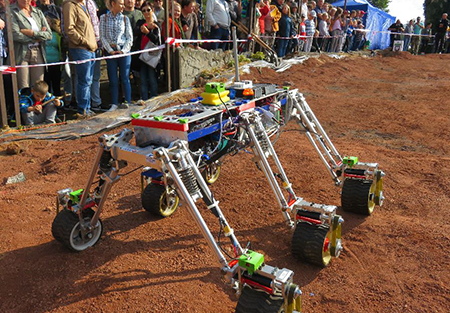
Mechanical Specialities
Theia-I has 6 independent wheels in order to traverse on rough terrain without affecting the center of mass. It has bicycle wheel design however after some test drives, we changed pulley rate from 1:1 to 1:2 so that Theia-I has more power. Despite the loss of velocity, rover is still fast enough to accomplish the tasks in a short time. Theia-I also has a robotic arm with 5 DoF(Degrees of Freedom) which can reach 1 meter away from arm’s base. For end-effector, there are several options with several designs. Gripper can be modified according to the given tasks. 2 or 3 finger grippers will be used accordingly while fingers can be either elastic material or stiff. If needed, gripper will be modified as shovel which can collect surface soil samples. Also, Theia-I has a drill which can collect deep soil samples in order to be analyzed with different types of chemicals. The final weight of Theia-I is approximately 50 kg with arm.
Electronics and Software Aspect
The codes for the control of Theia-I are written in Python, C++ and Arduino Programming Language. Matlab is also used in order to make some calculations, especially for the control of the robotic arm. Mostly python is used for control scripts; but for the 3D mapping with Lidar in autonomous mode, C++ is preferred. In the control station, rover is controlled with a computer with Ubuntu 16.04.4 LTS operating system and it communicates with the Jetson TX2 inside the robot with Ubuntu Mate 16.04.2 operating system. The motherboard is custom made PCB that designed by our team. This board is used to gather all locomotion controlling systems into a single board. The locomotion motherboard consists of an Arduino Mega and 6 pieces VNH2SP30 model motor driver. Using Pulse Width Modulation (PWM), Mega can adjust all motor speeds to the different values in once. The PWM values are taken from the Jetson TX2 via UART serial communication. The entire system of the UART communication is made via RS232 to USB cables.